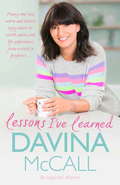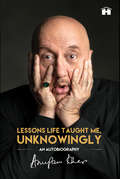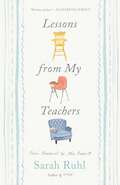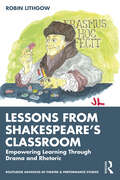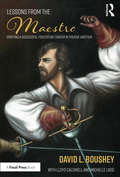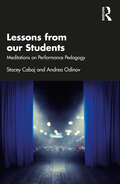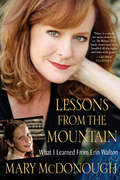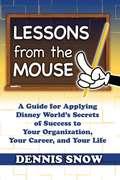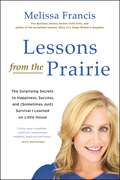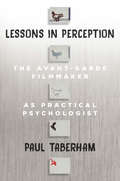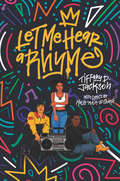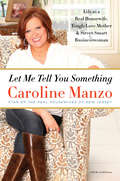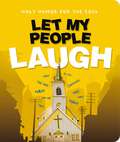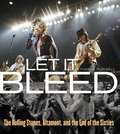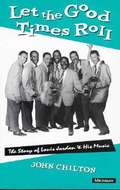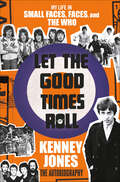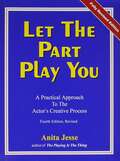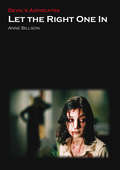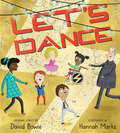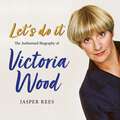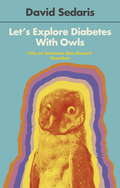- Table View
- List View
Lessons I've Learned
by Davina MccallWith her trademark humour, warmth and honesty, Davina McCall shares her life experiences."I am a work in progress. There are times when I feel in control and like I know what I'm doing . . . and there are times (quite a few) (actually lots) when I've got no idea what's going on, where to turn, what to do, how to behave, and those are the times I've sought help!I have been helped by some extraordinary people. I've been supported and counselled through my recovery from drugs and alcohol. I've been hypnotised to get me through my ultimate fears. I've read a squibillion (that's a lot) of fantastic self-help books and I have shared and shared with the greatest girlfriends and family of all time. These nuggets of wisdom have, at times, literally kept me going, so I thought I'd pay it forward and share them with you . . ."In this long-awaited book, Davina McCall shares the tips and wisdoms learned on her 'work-in-progess' journey through life.Warm, engaging, honest and generous, this book will make you laugh and cry in equal measure. Lessons I've Learned is the closest thing to a Davina hug and we all need one of those . . .
Lessons Life Taught Me, Unknowingly: An Autobiography
by Anupam KherAn extraordinary, riveting and no-holds-barred saga studded with fascinating behind-the-scenes revelations, anecdotes and rare nuggets of lessonsAnupam Kher’s life story is nothing short of a grand masala box office hit. It has drama, comedy, romance and even action! Who knew that a small-town Shimla boy would one day become one of the most recognised actors in the world and go on to win various national and international awards for his contribution in the field of cinema and arts?A powerhouse of talent with over 530 films (and counting) in his repertoire, Anupam Kher stands out not only because of his iconic bald head, but also for his forthright views and opinions, however controversial they may be. He has always been distinct and offbeat. His autobiography is, too . . . for it is not just another chronological account of his life. It is, in fact, also peppered with incredible life lessons that are bound to resonate with every aspiring artiste and, most of all, the common man.Here is a kaleidoscopic peep into the life and times of a true genius and forever entertainer.
Lessons from My Teachers: From Preschool to the Present
by Sarah RuhlAn inspiring meditation on the life-altering bonds between teacher and student and the ineffable wisdom imparted both inside and outside the classroom, from critically acclaimed author, MacArthur genius, two-time Pulitzer Prize finalist, and Tony Award–nominated playwright and author, Sarah Ruhl.Based on her popular class at Yale, this masterful, intimate essay collection from one of our greatest living playwrights and teachers, Sarah Ruhl, is a testament to the singular impact of teachers across every stage of our lives. Anchored in stories both personal and universal, drawing on Sarah&’s experiences with her parents and children, with schoolteachers, creative influences, and beyond, Lessons from My Teachers offers an uplifting perspective on our basic human need to teach and learn from each other as we navigate the surprising paths that shape our lives. Meant to be shared with loved ones and role models alike and perfect for marking important seasons and milestones, Lessons from My Teachers provides an opportunity to reflect on the human connection between teacher and student and the times in which we ourselves have assumed each role.
Lessons from Shakespeare’s Classroom: Empowering Learning Through Drama and Rhetoric (Routledge Advances in Theatre & Performance Studies)
by Robin LithgowThis volume explores the relationship between the emphasis on performance in Elizabethan humanist education and the flourishing of literary brilliance around the turn of the sixteenth century. This study asks us what lessons we can learn today from Shakespeare’s Latin grammar school. What were the cognitive benefits of an education so deeply rooted in what Demosthenes and Quintilian called "actio"—acting? Because of the vast difference between educational practice then and now, we have not often followed one essential thread: the focus on performance. This study examines the connections relevant to the education offered in schools today. This book will be of great interest to teachers, scholars, and administrators in performing arts and education.
Lessons from The Maestro: Crafting a Successful Fight/Stunt Career in Theatre and Film
by David L. BousheyIn Lessons from The Maestro: Crafting a Successful Fight/Stunt Career in Theatre and Film, famed Hollywood and theatre stuntman, trainer, and fight director David L. Boushey writes about his life, the history of stage and screen combat and stunt work, and how to enter the entertainment industry. Charting his illustrious career that spanned over 45 years, 400 theatre credits, and 45 films, Boushey narrates the events and decisions that lead him to enter the entertainment industry and documents for the first time his founding of multiple national and international associations for fight directors and stuntmen. He provides a roadmap for individuals aspiring to work in the theatre and film industry, providing information on training, auditioning, networking, unions, different paths one might take, and tips on how to be a successful stunt performer in a competitive industry. Part autobiography, part how-to guide to the entertainment business from the foremost authority in stage combat and stunt work, this is an invaluable resource for professional and aspiring fight and intimacy directors and stunt performers in theatre and film.
Lessons from our Students: Meditations on Performance Pedagogy
by Stacey Cabaj Andrea OdinovLessons from our Students: Meditations on Performance Pedagogy is a collection of thirty short personal case studies about pedagogical issues that arise in theater classrooms and rehearsals. Teaching in the acting and performance classroom is rapidly changing in the early 2020s. In the wake of the global pandemic, online education, massive trauma, and a social justice revolution, educators are seeking wisdom, clarity, and reassurance about their pedagogy. The authors speak to the current moment and the unique challenges of teaching theater by presenting a personal, practical, and authentic expression of vulnerability, humanity, and artistry as teachers. Through thirty personal meditations, the authors pose reflective questions and discussion prompts that evaluate the craft of teaching theater, issues that arise, and ideas about how to respond with vision and integrity. Accompanying exercises invite readers to reflect on their own teaching practices. This book serves as a text for theater teachers and teachers-in-training in search of inspiration, validation, and transformation in drama education and theater pedagogy classes.
Lessons from the Mountain: What I Learned From Erin Walton
by Mary McdonoughA fascinating look at what it's like to grow up in front of and beyond the cameras. --Eve PlumbFor nine seasons, Mary McDonough was part of one of the most beloved families in television history. Just ten years-old when she was cast as the pretty, wholesome middle child Erin, Mary grew up on the set of The Waltons, alternately embracing and rebelling against her good-girl onscreen persona. Now, as the first cast member to write about her experiences on the classic series, she candidly recounts the joys and challenges of growing up Walton--from her overnight transformation from a normal kid in a working class, Irish Catholic family, to a Hollywood child star, to the personal challenges that led her to take on a new role as an activist for women's body image issues. Touching, funny, sometimes heartbreaking, and always illuminating, Lessons from the Mountain is the story of everything Mary McDonough learned on her journey over--and beyond--that famous mountain. "For someone who started out as a sweet little girl afraid to speak up, it certainly is a pleasure to hear her shout from the top of the mountain now! --Alison Arngrim, New York Times bestselling author of Confessions of a Prairie Bitch"She's a radiant woman whose truth comes from within. . .if I had to pick one word that described Mary Beth, it would be resilience." --Earl Hamner, Creator of The Waltons"Mary is a whole lot more than Erin on The Waltons. This book shows how she's handled all the highs and lows with grace." -George Clooney Includes Never Before Published Bonus Chapter!
Lessons from the Mouse: A Guide for Applying Disney World's Secrets of Success to Your Organization, Your Career, and Your Life
by Dennis SnowWhat can you learn from a mouse? When that mouse has been delighting and entertaining hundreds of millions of people for decades - it turns out there is plenty to learn. Dennis Snow's Lessons From the Mouse provides ten no-nonsense, practical principles that anyone, anywhere can apply. He entertains while he educates with chapters like 'What Time is the 3:00 Parade?' Is Not a Stupid Question. The mouse is very candid here - no Disney pixie dust blinds the reader. Backstage snafus, onstage errors, and occasional chaos emerge in all their drama, humor, or irony. At its heart, though, Lessons From the Mouse presents ten lessons that guide readers in applying excellence in their own organizations, careers, and lives. Whether being used as a tool for increased organizational effectiveness or a pocket guide for the college grad or new entrepreneur, Lessons From the Mouse offers timeless, straightforward advice.
Lessons from the Prairie (Sometimes Just) Survival I Learned on America's Favorite Show: The Surprising Secrets To Happiness, Success, And (sometimes Just) Survival I Learned On America's Favorite Show
by Melissa FrancisMelissa Francis was only eight years old when she won the role of a lifetime: playing Cassandra Cooper Ingalls on the world's most famous prime-time soap opera, Little House on the Prairie.Now in Lessons from the Prairie, she shares behind-the-scenes stories from the set, and lessons learned from the show's dynamic creator, Michael Landon, that have echoed throughout Melissa's adult life. With novel insights on hard work, making mistakes, and even spirituality, Francis shares inspirational and practical life lessons that will appeal both to her current TV fans, and fans of one of the most adored TV shows of all time.
Lessons in Perception: The Avant-Garde Filmmaker as Practical Psychologist
by Paul TaberhamNarrative comprehension, memory, motion, depth perception, synesthesia, hallucination, and dreaming have long been objects of fascination for cognitive psychologists. They have also been among the most potent sources of creative inspiration for experimental filmmakers. Lessons in Perception melds film theory and cognitive science in a stimulating investigation of the work of iconic experimental artists such as Stan Brakhage, Robert Breer, Maya Deren, and Jordan Belson. In illustrating how avant-garde filmmakers draw from their own mental and perceptual capacities, author Paul Taberham offers a compelling account of how their works expand the spectator’s range of aesthetic sensitivities and open creative vistas uncharted by commercial cinema.
Let Me Hear a Rhyme
by Tiffany D JacksonIn this striking new novel by the critically acclaimed author of Allegedly and Monday’s Not Coming, Tiffany D. Jackson tells the story of three Brooklyn teens who plot to turn their murdered friend into a major rap star by pretending he's still alive. <P><P>Brooklyn, 1998. Biggie Smalls was right: Things done changed. But that doesn’t mean that Quadir and Jarrell are cool letting their best friend Steph’s music lie forgotten under his bed after he’s murdered—not when his rhymes could turn any Bed Stuy corner into a party. <P><P>With the help of Steph’s younger sister Jasmine, they come up with a plan to promote Steph’s music under a new rap name: the Architect. Soon, everyone wants a piece of him. When his demo catches the attention of a hotheaded music label rep, the trio must prove Steph’s talent from beyond the grave. <P><P>As the pressure of keeping their secret grows, Quadir, Jarrell, and Jasmine are forced to confront the truth about what happened to Steph. <P><P>Only, each has something to hide. And with everything riding on Steph’s fame, they need to decide what they stand for or lose all that they’ve worked so hard to hold on to—including each other.
Let Me Tell You Something: Life as a Real Housewife, Tough-Love Mother & Street-Smart Businesswoman
by Caroline ManzoRed-hot advice from the redhead who doesn't pull any punchesMother, wife, and fan favorite Caroline Manzo has been through it all as one of the original breakout stars of Bravo's The Real Housewives of New Jersey. The explosive and addicting reality series has seen some of the craziest moments in Real Housewives history, but Caroline has managed to set herself apart as the levelheaded, fiercely loyal, and down-to-earth member of the cast.Now for the first time, Caroline, who is known for her no-nonsense advice, "tells you something" about what it really takes to juggle three kids and a husband (and still maintain your sanity), all while living in the spotlight. Her wisdom on family, life, and love, and her shockingly honest confessions about beauty, body image, and even plastic surgery, resonate with women of every generation. Equal parts funny, sincere, and revealing, Caroline exposes the sweeter, more reflective side of herself that fans of the show might not always see.Filled with personal stories, family photos, and Caroline's characteristic humor, Let Me Tell You Something gives fans and readers an all-access, behind-the-scenes pass into the lives of this real New Jersey housewife and her family, where honest advice and practical life lessons are served up as only Caroline can. With her contagious, positive attitude and tips for success sprinkled throughout the book, readers will fall in love with their favor- ite housewife all over again.
Let My People Laugh
by Christianity Today InternationalIf laughter is the best medicine then these hysterical reflections on church life will bring joy and encouragement. Funny things happen in church...really funny things. And laughing about them can be one of the most healing, healthy, and encouraging things a pastor, church leader, or church member can do. This fun resource will provide instant laughs by bringing together some of the best "Church Laughs" content from Leadership Journal, Christianity Today's magazine for church leaders. High-quality, witty, silly, and just-plain funny cartoons and amusing anecdotes are also included. Let My People Laugh will bless and minister to folks in a way that sermons sometime can't!
Let it Bleed: The Rolling Stones, Altamont, and the End of the Sixties
by Gerard Van Der Leun Ethan A. RussellLET IT BLEED takes you where no Rolling Stones book has before. Author and photographer Ethan Russell was one of only sixteen people--including the Rolling Stones--who made up the 1969 tour. He was with them in their hotel rooms, at rehearsals, and on stage. He tells the story of this monumental and historic tour firsthand, including recollections from band members, crew, security, and other sixties icons--like Abbie Hoffman and Little Richard--they met along the way. And he also includes amazing photos of the performers who toured with the Stones that year: the legendary Tina Turner and B. B. King. Through vivid quotes taken from his interviews with the band and crew, and through more than 220 revealing photographs, Russell takes you behind the scenes for an uncensored look inside the Rolling Stones' world at the end of the sixties. It was an idealistic time, with an overarching belief that music could bring us all together. But the events that led to the terrible violence and stabbing death at Altamont would change rock and roll forever.
Let the Good Times Roll: My Life in Small Faces, Faces, and The Who
by Kenney Jones“Jones, the drummer for the Who after Keith Moon died, recalls his musical life in this modest and self-effacing rock and roll memoir.” —Publishers WeeklyFrom the Mod revolution and the British Invasion of the 1960s, through the psychedelic era of the 1970s, and into the exuberance and excesses of stadium rock in the 1980s, Kenney Jones helped to build rock and roll as we know it. He was the beat behind three of the world’s most enduring and significant bands.He wasn’t just in the right place at the right time. Along with Keith Moon, John Bonham, and Charlie Watts, Jones is regarded as one of the greatest drummers of all time, sought after by a wide variety of the best-known and best-selling artists to bring his unique skill into the studio for the recording of classic albums and songs—including, of course, the Rolling Stones’s “It’s Only Rock ‘n’ Roll (But I Like It).”And Jones is no shallow rock star. He may play polo with royalty from across the globe now, but this is the story of a ragamuffin from the East End of London, a boy who watched his bandmates, friends since his teens, die early, combated dyslexia to find a medium in which he could uniquely excel, and later found a way through the wilderness years when the good times seemed to have gone and he had little to fall back on.Kenney Jones has seen it all, played with everyone, and partied with all of them. Let the Good Times Roll is a breathtaking immersion into music past that leaves readers feeling as if they lived it too.
Let the Part Play You: A Practical Approach to the Actor's Creative Process (4th edition, Revised)
by Anita JesseA useful book for those looking to get into the art of acting, this book, irrespective of being amateurs or veterans, will be extremely helpful and guiding to anyone with questions. It has personalized practices, which do not require multiple people and is tailored to your specific focus in the acting world. The book is great mentor to the art that you are already crafting.
Let the Right One In
by Anne BillsonAudiences can't get enough of fang fiction. Twilight, True Blood, Being Human, The Vampire Diaries, Buffy the Vampire Slayer, Blade, Underworld, and the novels of Anne Rice and Darren Shan& mdash;against this glut of bloodsuckers, it takes an incredible film to make a name for itself. Directed by Tomas Alfredson and adapted for the screen by John Ajvide Lindqvist, The Swedish film Làt den rätte komma in (2008), known to American audiences as Let the Right One In, is the most exciting, subversive, and original horror production since the genre's best-known works of the 1970s. Like Twilight, Let the Right One In is a love story between a human and a vampire& mdash;but that is where the resemblance ends. Set in a snowy, surburban housing estate in 1980s Stockholm, the film combines supernatural elements with social realism. It features Oskar, a lonely, bullied child, and Eli, the girl next door. "Oskar, I'm not a girl," she tells him, and she's not kidding& mdash;she's a vampire. The two forge an intense relationship that is at once innocent and disturbing. Two outsiders against the world, one of these outsiders is, essentially, a serial killer. What does Eli want from Oskar? Simple companionship, or something else? While startlingly original, Let the Right One In could not have existed without the near century of vampire cinema that preceded it. Anne Billson reviews this history and the film's inheritence of (and new twists on) such classics as Nosferatu (1979) and Dracula (1931). She discusses the genre's early fliration with social realism in films such as Martin (1977) and Near Dark (1987), along with its adaptation of mythology to the modern world, and she examines the changing relationship between vampires and humans, the role of the vampire's assistant, and the enduring figure of vampires in popular culture.
Let the Right One In
by Anne BillsonAudiences can't get enough of fang fiction. Twilight, True Blood, Being Human, The Vampire Diaries, Buffy the Vampire Slayer, Blade, Underworld, and the novels of Anne Rice and Darren Shan& mdash;against this glut of bloodsuckers, it takes an incredible film to make a name for itself. Directed by Tomas Alfredson and adapted for the screen by John Ajvide Lindqvist, The Swedish film Làt den rätte komma in (2008), known to American audiences as Let the Right One In, is the most exciting, subversive, and original horror production since the genre's best-known works of the 1970s. Like Twilight, Let the Right One In is a love story between a human and a vampire& mdash;but that is where the resemblance ends. Set in a snowy, surburban housing estate in 1980s Stockholm, the film combines supernatural elements with social realism. It features Oskar, a lonely, bullied child, and Eli, the girl next door. "Oskar, I'm not a girl," she tells him, and she's not kidding& mdash;she's a vampire. The two forge an intense relationship that is at once innocent and disturbing. Two outsiders against the world, one of these outsiders is, essentially, a serial killer. What does Eli want from Oskar? Simple companionship, or something else? While startlingly original, Let the Right One In could not have existed without the near century of vampire cinema that preceded it. Anne Billson reviews this history and the film's inheritence of (and new twists on) such classics as Nosferatu (1979) and Dracula (1931). She discusses the genre's early fliration with social realism in films such as Martin (1977) and Near Dark (1987), along with its adaptation of mythology to the modern world, and she examines the changing relationship between vampires and humans, the role of the vampire's assistant, and the enduring figure of vampires in popular culture.
Let the Right One In
by Anne BillsonAudiences can't get enough of fang fiction. Twilight, True Blood, Being Human, The Vampire Diaries, Buffy the Vampire Slayer, Blade, Underworld, and the novels of Anne Rice and Darren Shan—against this glut of bloodsuckers, it takes an incredible film to make a name for itself. Directed by Tomas Alfredson and adapted for the screen by John Ajvide Lindqvist, The Swedish film Làt den rätte komma in (2008), known to American audiences as Let the Right One In, is the most exciting, subversive, and original horror production since the genre's best-known works of the 1970s. Like Twilight, Let the Right One In is a love story between a human and a vampire—but that is where the resemblance ends. Set in a snowy, surburban housing estate in 1980s Stockholm, the film combines supernatural elements with social realism. It features Oskar, a lonely, bullied child, and Eli, the girl next door. "Oskar, I'm not a girl," she tells him, and she's not kidding—she's a vampire. The two forge an intense relationship that is at once innocent and disturbing. Two outsiders against the world, one of these outsiders is, essentially, a serial killer. What does Eli want from Oskar? Simple companionship, or something else? While startlingly original, Let the Right One In could not have existed without the near century of vampire cinema that preceded it. Anne Billson reviews this history and the film's inheritence of (and new twists on) such classics as Nosferatu (1979) and Dracula (1931). She discusses the genre's early fliration with social realism in films such as Martin (1977) and Near Dark (1987), along with its adaptation of mythology to the modern world, and she examines the changing relationship between vampires and humans, the role of the vampire's assistant, and the enduring figure of vampires in popular culture.
Let's Dance
by David BowieFor David Bowie fans young and old comes a very special picture book celebrating dancing and being joyful while paying homage to an iconic musical figure."Let's dance. Put on your red shoes and dance the blues..." Embrace the spirit and mood of iconic musician David Bowie in this must-have book for any Bowie fan, especially those wanting to introduce a new generation to a favorite musical artist. Lightly adapting the lyrics to "Let's Dance" for a younger audience, kids and parents will soon be tapping their shoes to this lively book with bright, fun, whimsical artwork.
Let's Dance!
by Valerie BollingThis rhythmic showcase of dances from all over the world features children of diverse backgrounds and abilities tapping, spinning, and boogying away!Tap, twirl, twist, spin! With musical, rhyming text, author Valerie Bolling shines a spotlight on dances from across the globe, while energetic art from Maine Diaz shows off all the moves and the diverse people who do them. From the cha cha of Cuba to the stepping of Ireland, kids will want to leap, dip, and zip along with the dances on the page!
Let's Do It: The Authorised Biography of Victoria Wood
by Jasper ReesTrapeze audiobooks presents an extraordinary multi-voice tribute to one of Britain's most talented and most loved entertainers: Victoria Wood.This audiobook features narration from some of the extraordinary voices who worked with Victoria over her career:Susie BlakeRichenda CareyCelia ImrieDuncan PrestonAnne ReidDaniel RigbyKate RobbinsDavid ThrelfallJulie WaltersJane WymarkWith an introduction read by Jasper Rees and two recordings of Victoria Wood's classic Ballad of Barry and Freda.'I was born with a warped sense of humour and when I was carried home from being born it was Coronation Day and so I was called Victoria but you are not supposed to know who wrote this anyway it is about time I unleashed my pent-up emotions in a bitter comment on the state of our society but it's not quite me so I think I shall write a heart-warming story with laughter behind the tears and tears behind the laughter which means hysterics to you Philistines...'From 'Pardon?' by Vicky Wood, Aged 14. Bury Grammar School (Girls) Magazine, 1967In her passport Victoria Wood listed her occupation as 'entertainer' - and in stand-up and sketches, songs and sitcom, musicals and dramas, she became the greatest entertainer of the age. Those things that might have held her back - her lonely childhood, her crippling shyness and above all the disadvantage of being a woman in a male-run industry - she turned to her advantage to make extraordinary comedy about ordinary people living ordinary lives in ordinary bodies. She wasn't fond of the term, but Victoria Wood truly was a national treasure - and her loss is still keenly felt. Victoria had plenty of stories still to tell when she died in 2016, and one of those was her own autobiography. 'I will do it one day,' she told the author and journalist Jasper Rees. 'It would be about my childhood, about my first few years in showbusiness, which were really interesting and would make a really nice story.' That sadly never came to pass, so Victoria's estate has asked Jasper Rees, who interviewed her more than anyone else, to tell her extraordinary story in full. He has been granted complete and exclusive access to Victoria's rich archive of personal and professional material, and has conducted over 200 interviews with her family, friends and colleagues - among them Victoria's children, her sisters, her ex-husband Geoffrey Durham, Julie Walters, Celia Imrie, Dawn French, Anne Reid, Imelda Staunton and many more. What emerges is a portrait of a true pioneer who spoke to her audience like no one before or since.
Let's Explore Diabetes With Owls
by David SedarisA guy walks into a bar . . . From here the story could take many turns. A guy walks into a bar and meets the love of his life. A guy walks into a bar and finds no one else is there. When this guy is David Sedaris, the possibilities are endless. In Let's Explore Diabetes with Owls, Sedaris delights with twists of humour and intelligence, remembering his father's dinnertime attire (shirtsleeves and underpants) his first colonoscopy (remarkably pleasant) and the time he considered buying the skeleton of a murdered pygmy. By turns hilarious and moving, David Sedaris masterfully looks at life's absurdities as he takes us on adventures that are not to be forgotten.
Let's Explore Diabetes With Owls
by David SedarisFrom the unique perspective of David Sedaris comes a new book of essays taking his readers on a bizarre and stimulating world tour. From the perils of French dentistry to the eating habits of the Australian kookaburra, from the squat-style toilets of Beijing to the particular wilderness of a North Carolina Costco, we learn about the absurdity and delight of a curious traveler's experiences. Whether railing against the habits of litterers in the English countryside or marveling over a disembodied human arm in a taxidermist's shop, Sedaris takes us on side-splitting adventures that are not to be forgotten.
